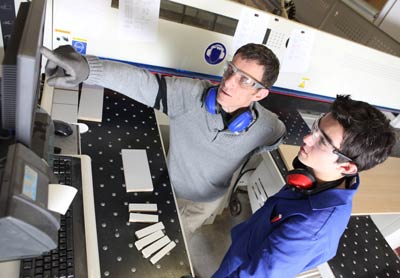 For years many maintenance technicians would wait until a spindle seized completely before taking action, and some would only find out a spindle is failing when the QA department decided to scrap the previous production run due to manufacturing defects. This kind of reactive maintenance approach can cost valuable time and tens of thousands of dollars in labor, material, and repair costs. It’s also detrimental to the long-term health of the machine.
For years many maintenance technicians would wait until a spindle seized completely before taking action, and some would only find out a spindle is failing when the QA department decided to scrap the previous production run due to manufacturing defects. This kind of reactive maintenance approach can cost valuable time and tens of thousands of dollars in labor, material, and repair costs. It’s also detrimental to the long-term health of the machine.
Fortunately, thanks to advances in predictive maintenance, and our decades of experience in high-tech spindle repair, we’ve developed various methods of monitoring machine health that can prevent breakdowns from happening in the first place and extend the life of your machines.
Proper Documentation is Essential
The value of proper training cannot be overstated. However, it’s not enough to train on how to perform basic spindle maintenance–you must also train your staff on why they’re performing the maintenance in the first place. The first step to knowing what’s going to happen is to observe what has already happened. This is why proper and detailed documentation of machine health is so essential.
Start by devising a plan. What skills are essential to maintain your most important equipment? Prioritize operation-critical machines first and expand incrementally. Utilize a third-party spindle repair service to make sure your staff is staying apprised of the latest technology and techniques. Ask your staff what skills they are most lacking. Having your entire maintenance team involved in the conversation is the best way to convey the importance of proper, continuous training.
Stop, Look, and Listen
Your machine operators are your first line of defense against early machine death. Ensuring that the crew members who interact with the spindles on a daily basis know the warning signs of machine health problems is essential to stay ahead of breakdowns. Scheduling regular visual inspections and utilizing checklists of high-priority areas, is a great way to streamline the inspection process. Ensure your personnel understand what each of the machine’s gauges means and when a readout suggests trouble. Every piece of equipment has acceptable operating parameters for oil level, temperature, pressure, etc., and if a machine is running outside those limits it can be a major red flag.
Train your operators to know what good machines sound like. Most people understand that grinding, squeaking and other irregular noises are indicators of a problem, but knowing what kind of problem these sounds suggest isn’t as common knowledge. For the record, these noises are all indicative of damaged bearings. Leaks or debris build-up around seals should be caught quickly, but often go ignored when machine operators don’t designate time to inspect the equipment. We recommend training your staff to be familiar with the guidelines below for proper spindle installation and inspection.
PROPER SPINDLE INSTALLATION OVERVIEW
- Trim Balance
- Vibration Baseline
- Blow out debris lube lines
- Inspect tool retention
- Alignment and Runout baseline
- Monitor Temperature
- Belt tension and transmitted vibration
SPINDLE/MACHINE INSPECTION
- Coolant Temperature and Flow
- Spindle Operating Temperature
- Vibration Baseline (balance
- alignment and bearings)
- Lube flow and settings (except
- for grease spindles)
- Air purge setting
- Drawbar tooling retention
- Tooling/taper runout and fit
We understand that manufacturing floors are busy places but ensuring that your team has enough time to stop, look, and listen to their equipment can save tens-of-thousands of dollars in the long-run.
Utilize Vibration Analysis
Utilizing vibration analysis programs is one of the most important things you can do to stay competitive. While the algorithms in these smart programs are impressive, they are nothing on their own. Proper vibration analysis, just like all tools, requires insight and experience to get the best results. Your staff must understand which metrics are relevant to your equipment and know what the data means to make informed decisions. The best preventative maintenance programs rely on the staff members’ insight and training to work in tandem with the software. Vibration data starts with a baseline measurement and tracks trends over time to detect problems. Properly trained maintenance staff should be aware of the proper data collection protocols below.
- Always measure at the same speed and the same load.
- Know how to set up the optimal conditions for measurement.
- Conduct monthly data collection during a maintenance shut down or shift change.
- Keep machine measurement routes short and easy to finish.
- For most spindles, a single measurement point per spindle will give you a good trend.
- Data can be collected from permanently mounted vibration sensors.
Once a vibration analysis program is established other data points, such as temperature or lubrication, can be utilized to provide even more accurate predictions.
When you do send your equipment to a third-party spindle repair provider, ensure you’re using a company that can provide a vibration certification report. If your installed vibration readings are significantly different from the shop report, then there could be other components in the system that are contributing to the vibration problems.
To get the most out of your machines, and make breakdowns a thing of the past, contact the professionals at GTI Spindle Technology today.
About GTI Spindle Technology
At GTI Spindle Technology, we specialize in high-quality spindle diagnosis and repair. Getting your business back into full operation and minimizing downtime is our mission. We offer in-house, on-site, and emergency assistance for machine tool spindle failure analysis, spindle repair, and complete spindle testing. With an extensive range and expertise in a diverse group of industries, our customers know that they are getting the highest quality of spindle repair and customer service. Click here to find out more.

